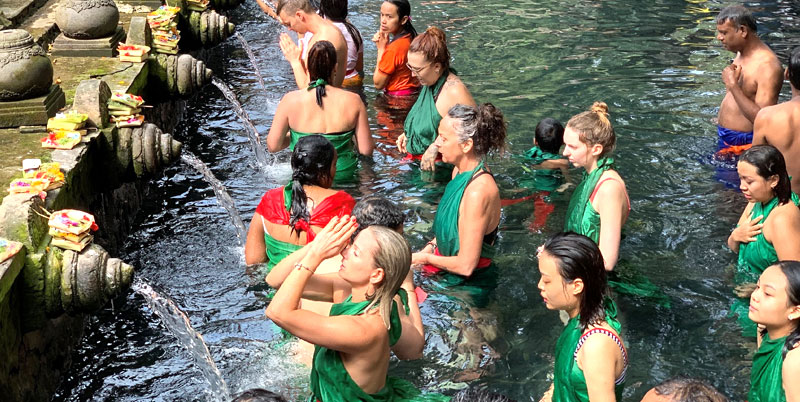TIRTA EMPUL TEMPLE
TIRTA EMPUL TEMPLE LOCATED NEAR INDONESIAN PRESIDENT PALACE IT IS SET IN THE DALE AND ENCIRCLED BY THE HILL AND POPULAR TOURISM SITE IN BALI ISLAND
Tirta Empul Temple is a beautiful temple complex and holy mountain spring located in the village of Manukaya in central Bali. The site serves as a legendary setting of a traditional tale about good versus evil, it's also a national cultural heritage site. The complex built in 960 AD is also a silent witness to the old Balinese kingdom years, particularly at the time of the Warmadewa Dynasty. Another nearby and prominent site on top of a hill is the presidential palace, Istana Tampaksiring, built during the years of the nation's first president, Soekarno.
How to Get to Tirta Empul Temple
Tirta Empul Temple is located in the village of Manukaya, Tampaksiring Distric, Gianyar Regency, Bali. It’s pretty easy to get to the Tirta Empul Temple and can be reached by many sides besides from central town of Ubud, from eastern corner of Ubud and from southern area of Ubud. As the distance from Denpasar airport is around 54 km, from Kuta around 50 km, from Seminyak around 50 kms and from Ubud area around 30-minute drive to the north. The temple is situated just below the Presidential Palace of Tampaksiring. Built in 1957 by Indonesia's first president, Soekarno, the beautifully built palace itself is an important landmark of the island and the country.
Best Time to Visit Tirta Empul Temple
Though it is advisable and seen that the evening visits especially on the full moon nights are truly mesmerizing and keep you spellbound, the best timings for Tirta Empul Temple visit is around 08.00 AM to to 02.00 PM. This is a good time all through the yearly calendar as during morning visitor’s rush is rare and is very less. The earlier you arrive, the less likely are you to experience large crowds.
What to Expect at Tirta Empul Temple
As soon as you enter temple, you will walk through the large stone Balinese gate (locally known as Candi Bentar) and arrive in the outer courtyard of the temple. This area of the temple is called Jaba Pura. At the end of the courtyard is another Candi Bentar built into the wall that leads to the central courtyard. This gate is guarded by smoothly carved huge statues of two Dwarapala or guardians given a brush of golden colors. At the top of the gate is a carving of Kala which is quite different than other Kala carvings elsewhere since it has fangs that stick upwards and a pair of hands with open arms.
Entering the inner courtyard, you will arrive at the 'Jaba Tengah' area which is the main area of the temple. The holy springs here bubble up into a large, crystal-clear pool within the temple and gush out through 30 waterspouts into the two sacred purification pools. Local Balinese and Hindu worshipers stand in long lines in the pools waiting to dip their heads under the water spouts in a purification ritual known as "melukat". Bathers start in the pool on the left side standing in the pool to the waist under the first water spout. Once they have cleansed themselves under the first spout they join the next queue.
This process is continued until they have cleansed themselves under each waterspout. However, there are two spouts that are meant only for cleansing the dead and are for prohibited to be used by the living for the melukat ritual. Behind the purification pools is the final section of the Tirta Empul Holy Water Temple, called the Jeroan. Mostly overlooked by tourists, the jeroan or inner courtyard is a pleasant place to visit and relax after the hustle and bustle of the purification pools. This is where people come to pray. The front part of the courtyard is dominated by the large water spring that feeds the purification pools.
The spring is filled with green algae and small fish swim among the reeds. Behind the springs are large Hindu shrines. This part of the temple is nice to quickly explore. The shrines are brightly decorated, which contrasts with the starched white clothing of the Balinese who come here to pray. As you exit Tirta Empul Temple you pass through a large pool filled with koi fish.This section of the temple is walled off on all four sides from the rest of the complex, which gives it a calm and relaxing atmosphere. Fat koi swim lazily in the pond waiting for their next meal.
Tirta Empul Temple History
Tirta Empul Temple is one of the largest and busiest water temples in Indonesia. The temple was founded in 926 A.D. is a silent witness to the old Balinese kingdom, particularly at the time of the Warmadewa Dynasty. Besides the beautiful and the eye craving sights of this place, there are many myths and some of the true facts associated with this place. The Balinese believe that the creation of Tirta Empul Temple involves the legend of an epic battle between a powerful and magical king named Mayadenawa and the God Indra.
Mayadenawa possessed the spiritual power to transform himself into any form he desired. But he became careless with his powers and used them for black magic. A priest named Sang Kulputih prayed to the God Indra to put an end to the evil king. Indra and his soldiers managed to defeat Mayadenawa's forces, and left the wicked king and what's left of his troops running for their life. Later, Mayadenawa snuck into Indra's camp when the army slept. He created a beautiful but poisonous pond that the army would drink from upon waking up.
When Mayadenawa crept into the camp, he walked on the sides of his feet so as not to leave footprints- thus this is believed to be the origin of the name "Tampak Siring" which translates as "tilted footprint". In the morning Indra awoke to find many of his men dead and scores more sick and dying. It was then, through his mighty power that the God Indra pierced the ground with his staff, creating the sacred healing springs of holy water which came to be known as Tirta Empul. Knowing that his plan had failed, Mayadenawa frantically tried to transform himself into all sorts of different beings but to no avail, since Indra continued to chase him.
When at last he transformed himself into a boulder, Indra shot an arrow through it, pierced and eventually killed the evil king. The blood of Mayadenawa that gushed from the boulder is believed to have formed the Petanu River, and for over a thousand years, the river was cursed making rice to grow rapidly, but having an awful reek and tainted with blood. The Hindu Balinese commemorate the death of Mayadenawa every 210 days in the Balinese traditional calendar as the day when Virtue triumphs over Evil in the ritual and ceremony called Galungan.
Tirta Empul Temple Entrance Ticket
Adult : IDR 50,000Children : IDR 25,000
Opening Hours : 09.00 AM - 05.00 PM
Explore Related Bali Rafting Tour to Tirta Empul Temple
Telaga Waja Rafting and Tirta Empul Temple Tour
Telaga Waja Rafting and Tirta Empul Temple Tour is exciting tours between rafting in telaga waja river and visiting Tirta Empul Temple, Tegalalang Rice Terrace and Tegenungan Waterfall ..... Read More
Ayung River Rafting and Tirta Empul Tour
Ayung River Rafting and Tirta Empul Tour is exciting tours between 2 hours white water rafting in ayung river ubud and visiting Tirta Empul Temple, Tegalalang Rice Terrace and Tegenungan Waterfall ..... Read More
Melangit River Rafting and Tirta Empul Tour
Melangit River Rafting and Tirta Empul Tour is exciting tours between 1,5 hours white water rafting in melangit river and visiting Tirta Empul Temple, Tegalalang Rice Terrace and Tegenungan Waterfall ..... Read More
TELAGA WAJA RAFTING PACKAGES
- Telaga Waja Rafting and Shopping Tour
- Telaga Waja Rafting and Tirta Empul Tour
- Telaga Waja Rafting and Ubud Full Day Tour
- Telaga Waja Rafting and Bali Waterfalls Tour
- Telaga Waja Rafting and Kintamani Day Tour
- Telaga Waja Rafting and Besakih Full Day Tour
- Telaga Waja Rafting and Uluwatu Full Day Tour
- Telaga Waja Rafting and Besakih Kintamani Tour
- Telaga Waja Rafting and Spa Packages
- Telaga Waja Rafting and Trekking Packages
- Telaga Waja Rafting and ATV Ride Packages
- Telaga Waja Rafting and Bali Swing Packages
- Telaga Waja Rafting and Seawalker Packages
- Telaga Waja Rafting and Safari Park Packages
- Telaga Waja Rafting and Water Sport Packages
- Telaga Waja Rafting and Horse Riding Packages
- Telaga Waja Rafting and Elephant Ride Packages
- Telaga Waja Rafting and Blue Lagoon Snorkeling
- Telaga Waja Rafting and Canyon Trekking
- Telaga Waja Rafting + Bali Swing + Spa
- Telaga Waja Rafting + ATV Ride + Spa
- Telaga Waja Rafting + Horse Riding + Spa
- Telaga Waja Rafting + Elephant Ride + Spa
AYUNG RIVER RAFTING PACKAGES
- Ayung River Rafting and Shopping Tour
- Ayung River Rafting and Tirta Empul Tour
- Ayung River Rafting and Ubud Full Day Tour
- Ayung River Rafting and Best Waterfalls Tour
- Ayung River Rafting and Uluwatu Full Day Tour
- Ayung River Rafting and Ulun Danu Temple Tour
- Ayung River Rafting and Tanah Lot Full Day Tour
- Ayung River Rafting and Besakih Kintamani Tour
- Ayung River Rafting and Kintamani Day Tour
- Ayung River Rafting and Spa Packages
- Ayung River Rafting and Canyon Trekking
- Ayung River Rafting and Cycling Packages
- Ayung River Rafting and Trekking Packages
- Ayung River Rafting and ATV Ride Packages
- Ayung River Rafting and Bali Swing Packages
- Ayung River Rafting and Safari Park Packages
- Ayung River Rafting and Horse Riding Packages
- Ayung River Rafting and Elephant Ride Packages
- Ayung River Rafting and Blue Lagoon Snorkeling
- Ayung River Rafting and Water Sport Packages
- Ayung River Rafting and Seawalker Packages
- Ayung River Rafting and Seafood Dinner
- Ayung River Rafting and Bali Bird Park
- Ayung River Rafting + Cycling + Spa
- Ayung River Rafting + ATV Ride + Spa
- Ayung River Rafting + Seawalker + Spa
- Ayung River Rafting + Bali Swing + Spa
- Ayung River Rafting + Horse Riding + Spa
- Ayung River Rafting + Elephant Ride + Spa
MELANGIT RIVER RAFTING PACKAGES
- Melangit River Rafting and Shopping Tour
- Melangit Rafting and Uluwatu Full Day Tour
- Melangit River Rafting and Tirta Empul Tour
- Melangit Rafting and Besakih Kintamani Tour
- Melangit River Rafting and Ubud Full Day Tour
- Melangit River Rafting and Tanah Lot Day Tour
- Melangit River Rafting and Kintamani Day Tour
- Melangit River Rafting and Best Waterfalls Tour
- Melangit River Rafting and Water Sport Packages
- Melangit River Rafting and Safari Park Packages
- Melangit River Rafting and Bali Swing Packages
- Melangit River Rafting and Seawalker Packages
- Melangit River Rafting and ATV Ride Packages
- Melangit River Rafting and Trekking Packages
- Melangit Rafting and Blue Lagoon Snorkeling
- Melangit River Rafting and Canyon Trekking
- Melangit River Rafting and Seafood Dinner
- Melangit River Rafting and Spa Packages
- Melangit River Rafting and Elephant Ride
- Melangit River Rafting and Horse Riding
- Melangit River Rafting and Bali Bird Park
- Melangit River Rafting + Bali Swing + Spa
- Melangit River Rafting + ATV Ride + Spa
- Melangit River Rafting + Horse Riding + Spa
- Melangit River Rafting + Elephant Ride + Spa






